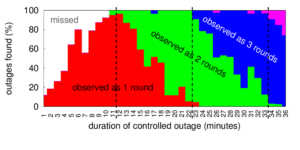The paper “Trinocular: Understanding Internet Reliability Through Adaptive Probing” was accepted by SIGCOMM’13 in Hong Kong, China (available at http://www.isi.edu/~johnh/PAPERS/Quan13c with cite and pdf, or direct pdf).

From the abstract:
Natural and human factors cause Internet outages—from big events like Hurricane Sandy in 2012 and the Egyptian Internet shutdown in Jan. 2011 to small outages every day that go unpublicized. We describe Trinocular, an outage detection system that uses active probing to understand reliability of edge networks. Trinocular is principled: deriving a simple model of the Internet that captures the information pertinent to outages, and populating that model through long-term data, and learning current network state through ICMP probes. It is parsimonious, using Bayesian inference to determine how many probes are needed. On average, each Trinocular instance sends fewer than 20 probes per hour to each /24 network block under study, increasing Internet “background radiation” by less than 0.7%. Trinocular is also predictable and precise: we provide known precision in outage timing and duration. Probing in rounds of 11 minutes, we detect 100% of outages one round or longer, and estimate outage duration within one-half round. Since we require little traffic, a single machine can track 3.4M /24 IPv4 blocks, all of the Internet currently suitable for analysis. We show that our approach is significantly more accurate than the best current methods, with about one-third fewer false conclusions, and about 30% greater coverage at constant accuracy. We validate our approach using controlled experiments, use Trinocular to analyze two days of Internet outages observed from three sites, and re-analyze three years of existing data to develop trends for the Internet.
Citation: Lin Quan, John Heidemann and Yuri Pradkin. Trinocular: Understanding Internet Reliability Through Adaptive Probing. In Proceedings of the ACM SIGCOMM Conference. Hong Kong, China, ACM. August, 2013. <http://www.isi.edu/~johnh/PAPERS/Quan13c>.
Datasets (listed here) used in generating this paper are available or will be available before the conference presentation.

